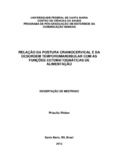| dc.creator | Weber, Priscila | |
| dc.date.accessioned | 2012-12-20 | |
| dc.date.available | 2012-12-20 | |
| dc.date.issued | 2012-02-27 | |
| dc.identifier.citation | WEBER, Priscila. RELATION OF THE CRANIOCERVICAL POSTURE AND
TEMPOROMANDIBULAR DISORDER WITH THE STOMATOGNATHIC
ALIMENTAIRES FUNCTIONS. 2012. 143 f. Dissertação (Mestrado em Fonoaudiologia) - Universidade Federal de Santa Maria, Santa Maria, 2012. | por |
| dc.identifier.uri | http://repositorio.ufsm.br/handle/1/6524 | |
| dc.description.abstract | Craniocervical posture can interfere directly on the mandibular and hyoid bone
position as well as on the masticatory and swallowing functions. On the other hand a
stomatognathic alteration such as temporomandibular disorder (TMD) can be a
harmful factor on the alimentaires functions. This study aimed to investigate the
craniocervical posture and TMD relation on the masticatory and swallowing functions.
70 women were divided according to TMD diagnostic evaluated by the Research
Diagnostic Criteria (RDC/TMD): 34 with TMD and 36 without signs and symptoms of
TMD. Craniocervical posture and mandibular and hyoid bone variables were
measured by cephalometric analysis. Masticatory and swallowing function evaluation
was performed according to a protocol of orofacial myofunctional evaluation with
Scores (OMES). It was observed significant correlations between craniovertebral
angle and hyoid bone position variables: linear distance from the hyoid bone to the
menton (p=0,02) and to the mandible (p=0,03). The angle which measured the
anterior position of the head also demonstrated a significant correlation with the
linear distance between hyoid bone and jaw (p=0,00). Degree of cervical curvature
showed a correlation between the linear distance from hyoid bone to the third
cervical vertebra (p=0,01). An important craniocervical postural change was
observed in the group although there was no association between them and a higher
frequency of atypical behaviors evaluated during masticatory and swallowing
functions. TMD subjects showed a significant difference on tongue (p=0,03) and lip
(p=0,04) posture during swallowing. Chronic unilateral chewing pattern was also
observed in the TMD group (p=0,03). In spite of the anatomical relation between
craniocervical posture and mandibular and hyoid bone position it was not possible to
confirm that the postural alterations observed could be associated to damages on
masticatory and swallowing functions. Nonetheless, TMD presence resulted on a
higher frequency of myofunctional alterations during these functions. | eng |
| dc.description.sponsorship | Coordenação de Aperfeiçoamento de Pessoal de Nível Superior | |
| dc.format | application/pdf | por |
| dc.language | por | por |
| dc.publisher | Universidade Federal de Santa Maria | por |
| dc.rights | Acesso Aberto | por |
| dc.subject | Transtornos da articulação temporomandibular | por |
| dc.subject | Postura | por |
| dc.subject | Cefalometria | por |
| dc.subject | Mastigação | por |
| dc.subject | Deglutição | por |
| dc.subject | Temporomandibular joint disorders | eng |
| dc.subject | Posture | eng |
| dc.subject | Cephalometry | eng |
| dc.subject | Mastication | eng |
| dc.subject | Swallowing | eng |
| dc.title | Relação da postura craniocervical e da desordem temporomandibular com as funções estomatognáticas de alimentação | por |
| dc.title.alternative | Relation of the craniocervical posture and
temporomandibular disorder with the stomatognathic alimentaires functions | eng |
| dc.type | Dissertação | por |
| dc.description.resumo | A postura craniocervical pode interferir diretamente na posição da mandíbula
e do osso hióide e conseqüentemente na realização das funções de mastigação e
deglutição. Outro fator que pode repercutir nocivamente sobre as funções
alimentares seria uma alteração do próprio sistema, como por exemplo, a presença
de uma Desordem Temporomandibular (DTM). Este estudo teve como objetivo
investigar a relação da postura craniocervical e da DTM com as funções de
mastigação e deglutição. 70 indivíduos do gênero feminino foram divididos em dois
grupos quanto à presença de DTM segundo o instrumento Critérios de Diagnóstico
para Pesquisa de Desordem Temporomandibular (RDC/TMD): 34 indivíduos com
DTM e 36 sem DTM. A postura craniocervical e a posição mandibular e do osso
hióide foram aferidas pela análise cefalométrica. A avaliação das funções de
mastigação e deglutição foi baseada no Protocolo de Avaliação Miofuncional
Orofacial com Escores (AMIOFE). Foram observadas correlações significativas entre
o ângulo crânio-vertebral e as variáveis referentes à posição do osso hióide:
distância do osso hióide ao mento (p=0,02) e à mandíbula (p=0,03). O ângulo
referente à anteriorização da cabeça também apresentou uma correlação
significativa com a medida relativa à distância do osso hióide à mandíbula (p=0,00).
O grau de curvatura cervical demonstrou uma correlação moderada em relação à
distância do osso hióide à terceira vértebra cervical (p=0,01). Foram observadas
alterações posturais importantes, porém estas não foram associadas à maior
freqüência de comportamentos atípicos durante as funções de mastigação e
deglutição. Os indivíduos com DTM apresentaram uma diferença significativa quanto
à postura de língua (p=0,03) e lábios (p=0,04) durante a função de deglutição, bem
como a adoção de um padrão mastigatório unilateral crônico (p=0,03) mais
freqüentemente observado. Os achados cefalométricos confirmaram a relação
anatômica entre a postura craniocervical, mandíbula e osso hióide. No entanto, não
foi possível associar a presença dos desvios posturais craniocervicais observados
com a ocorrência de alterações nas funções de mastigação e deglutição. Por outro
lado, a presença da DTM repercutiu na maior freqüência de alterações nas funções
alimentares. | por |
| dc.contributor.advisor1 | Corrêa, Eliane Castilhos Rodrigues | |
| dc.contributor.advisor1Lattes | http://buscatextual.cnpq.br/buscatextual/visualizacv.do?id=K4787159D7 | por |
| dc.contributor.advisor-co1 | Silva, Ana Maria Toniolo da | |
| dc.contributor.advisor-co1Lattes | http://buscatextual.cnpq.br/buscatextual/visualizacv.do?id=K4777172E1 | por |
| dc.contributor.referee1 | Mezzomo, Carolina Lisbôa | |
| dc.contributor.referee1Lattes | http://buscatextual.cnpq.br/buscatextual/visualizacv.do?id=K4779654H0 | por |
| dc.contributor.referee2 | Ries, Lilian Gerdi Kittel | |
| dc.contributor.referee2Lattes | http://lattes.cnpq.br/4671644048779926 | por |
| dc.creator.Lattes | http://lattes.cnpq.br/7772202949497289 | por |
| dc.publisher.country | BR | por |
| dc.publisher.department | Fonoaudiologia | por |
| dc.publisher.initials | UFSM | por |
| dc.publisher.program | Programa de Pós-Graduação em Distúrbios da Comunicação Humana | por |
| dc.subject.cnpq | CNPQ::CIENCIAS DA SAUDE::FONOAUDIOLOGIA | por |


